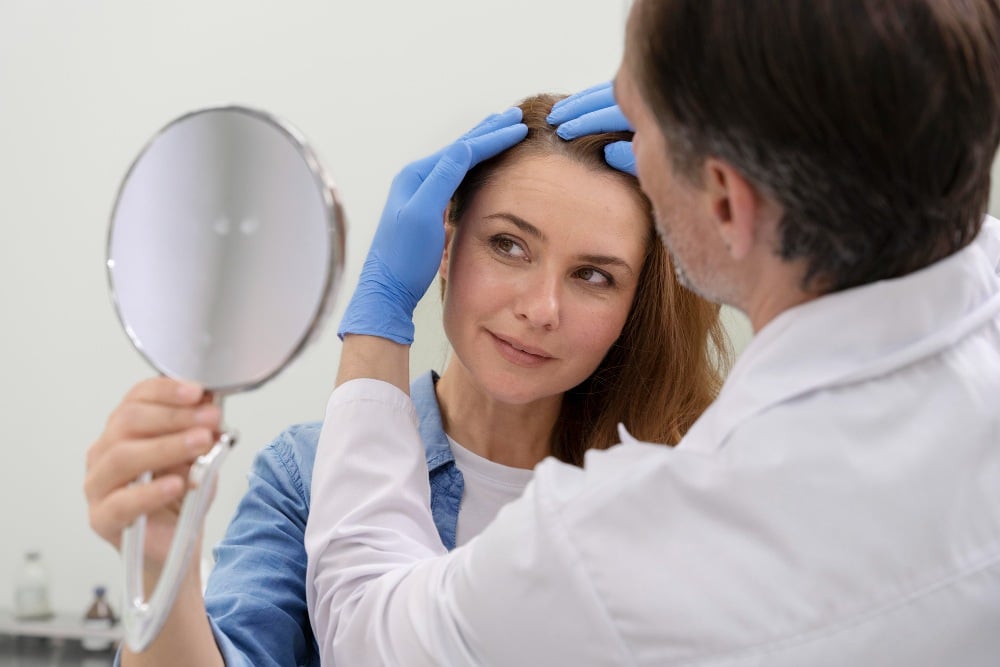Understanding Hair Loss: Assessment, Investigations, and Treatments
Hair loss, or alopecia, is a common concern affecting millions of people worldwide. While hair thinning and shedding can be distressing, understanding the underlying causes, conducting thorough assessments, and exploring treatment options can offer hope for those experiencing this condition. In this blog, we’ll take a closer look at the various types of hair loss, the diagnostic process, and available treatments.
Types of Hair Loss
Before delving into the assessment and treatment of hair loss, it’s important to understand that there are different types of hair loss, each with its own causes:
- Androgenetic Alopecia: Often called male or female pattern baldness, this is the most common form of hair loss and is largely hereditary. It results from the effects of hormones (androgens) on genetically predisposed hair follicles.
- Telogen Effluvium: A temporary form of hair loss caused by stress, illness, surgery, or nutritional deficiencies. It involves the premature transition of hair into the resting (telogen) phase.
- Alopecia Areata: An autoimmune condition where the body’s immune system attacks hair follicles, leading to patchy hair loss. It can affect any area of the body, including the scalp.
- Traction Alopecia: Hair loss caused by prolonged tension or pulling on the hair, often due to tight hairstyles like braids or ponytails.
- Scarring Alopecia: A group of rare disorders where hair follicles are destroyed due to inflammation, leading to permanent hair loss.
Assessment and Investigations for Hair Loss
When assessing hair loss, a comprehensive approach is essential to identify the cause and determine the most effective treatment. Here’s how the assessment process typically unfolds:
1. Answer some questions for us
- When did the hair loss start, and has it progressed gradually or suddenly?
- Are there any associated symptoms, such as itching, redness, or scalp tenderness?
- Are there any recent stressful events, illnesses, or surgeries?
- What medications or supplements is the patient taking?
- Is there a family history of hair loss or autoimmune conditions?
2. Scalp Examination
The next step is a thorough scalp examination. Dr Tina Fang will look for signs of inflammation, scarring, or patterns of hair thinning. Hair pull tests, where small sections of hair are gently tugged, can determine if there is active shedding. The distribution and pattern of hair loss are key indicators in differentiating types of alopecia.
3. Trichoscopy
Trichoscopy is a non-invasive diagnostic tool that involves the use of a dermatoscope to magnify and examine the scalp and hair follicles. This method helps visualise follicular openings, hair shaft abnormalities, and signs of inflammation, aiding in the diagnosis of conditions like androgenetic alopecia or alopecia areata.
4. Blood Tests
Blood tests are often conducted to rule out underlying medical conditions that may contribute to hair loss. Common tests include:
- Thyroid function tests: To identify hypothyroidism or hyperthyroidism.
- Ferritin levels: To check for iron deficiency, a common cause of hair shedding.
- Hormonal assessments: Especially in women, where polycystic ovarian syndrome (PCOS) or hormonal imbalances might contribute to androgenetic alopecia.
- Autoimmune panels: If alopecia areata is suspected, screening for autoimmune markers can be helpful.
5. Scalp Biopsy
In cases where the diagnosis is unclear or scarring alopecia is suspected, a scalp biopsy may be performed. This involves removing a small sample of scalp tissue for microscopic examination, which can reveal inflammatory or scarring processes.

Treatment Options for Hair Loss
Once the underlying cause of hair loss is determined, an individualised treatment plan can be developed. Dr. Tina Fang offers non-surgical, regenerative treatments to stimulate natural hair growth. Here are some of the options available:
1. Platelet-Rich Plasma (PRP) Therapy
PRP therapy involves drawing a small amount of the patient’s blood, processing it to concentrate the platelets, and injecting the platelet-rich plasma back into the scalp. Platelets contain growth factors that can help stimulate hair follicle activity and promote hair growth. PRP is a popular, minimally invasive option for treating androgenetic alopecia and other forms of hair loss.
2. Exosome Therapy
Exosome therapy involves injecting exosomes (small vesicles involved in cell communication) into the scalp. These exosomes contain growth factors and proteins that can promote hair regeneration and healing at the cellular level. This therapy is promising for individuals looking for innovative, non-surgical solutions to hair thinning.
3. Regenera Activa
Regenera Activa is a regenerative medicine technique that uses micrografts from the patient’s own tissue to stimulate hair growth. In this procedure, a small skin sample is collected, and progenitor cells from this sample are processed and re-injected into the scalp. This method enhances the natural regenerative capacity of hair follicles, making it an effective treatment for androgenetic alopecia and other forms of hair thinning.
4. Topical Treatments
- Minoxidil: Minoxidil is a well-known topical treatment that helps stimulate hair growth by increasing blood flow to the scalp. It is available over the counter and is often recommended for patients with androgenetic alopecia.
- Nutritional Supplements: If nutritional deficiencies are contributing to hair loss, supplements such as biotin, zinc, and iron can be incorporated into the treatment plan to support hair growth.
Final Thoughts
Hair loss is a multifaceted issue that requires a personalised approach to diagnosis and treatment. Whether the cause is hormonal, autoimmune, stress-related, or due to other factors, seeking professional help can lead to effective interventions and improved outcomes. Early assessment and intervention are key to managing hair loss and preventing further progression.
Dr. Tina Fang offers a range of regenerative therapies designed to restore your hair naturally. If you’re experiencing hair loss, contact Dr Tina today to schedule an assessment and explore the best treatment options for your needs.




